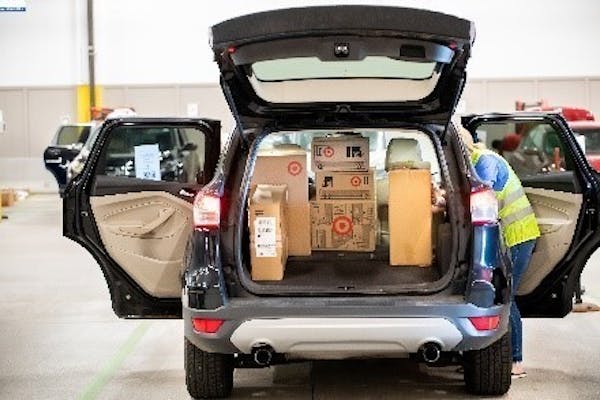When the weather is cold and her family has been stuck in the house, Libby Boxall bundles up her kids and heads to Target.
"Target has everything," said Boxall, 34. "If you want to, you can get your groceries. Now they've got the Ulta section so I can go and get any makeup that I want. ... If my kids have been good, their treat is to go to Target and pick out a toy.
"It's like retail therapy and a good way to get out of the house."
Minneapolis-based retailers Target and Best Buy have seen demand cool after the pandemic-driven buying frenzy, with their earnings reports this week likely to show declines in sales compared to the previous year. But shoppers like Boxall prove big box isn't dead.
More people are shopping in stores. Plus with fewer supply-chain shortages and COVID-19 rules to navigate, analysts and researchers say retailers are in a better position to attract new customers, cut costs and improve efficiencies.
"If you are a general merchandiser, you made all of these changes during the pandemic, during a crisis," said David Alexander, a marketing professor at the University of St. Thomas. "You don't want to take back [services] that people really love. You are trying to reduce costs. You are trying to bring things back to a happy medium."
New needs
Last year, retailers saw their first indication that the glory days of double- and even triple-digit sales growth were past. In November, Target reported modest quarterly comparable sales growth of 2.7%. Company leaders told investors they expected a low single-digit decline in comparable sales in the last quarter, which ended in January.
Best Buy performed better than what a cautious Wall Street expected. However, sales still dropped more than 10% as people bought fewer electronics, likely after stocking up during the pandemic. Best Buy executives said they expected comparable sales to drop about 10% for both the recent quarter and the full year.
Both companies have already taken steps to persevere.
Last week, Target announced a $100 million investment to expand its network of sorting facilities that help make online order deliveries quicker and cheaper. Company leaders have also said the retailer is emphasizing its value to consumers, including offering different entry price-point options for its store brands.
Best Buy is engaging customers through more "experiential stores," such as the one in Minnetonka offering hands-on experiences for customers to try out technology like its new e-bikes.
The U.S. Census Bureau said overall retail sales in January were up 6.4% year over year. However, after removing car sales, gas sales and restaurant revenue, core retail sales were up 4.8% compared to last year, which is still below the 6.4% increase in the price of consumer goods in January. People are buying less stuff, but it's costing more.
"What we are seeing is a pullback in impulse purchases, discretionary spending on non-necessities," said Marshal Cohen, chief industry adviser for market research firm NPD Group. "And even in some cases, necessities are starting to see a shift … where [consumers] are buying lower-priced products."
That benefits retailers like Walmart, known for its "everyday low prices." Target, though, has executed a "mastery of the middle," said Ethan Chernofsky, senior vice president of marketing at Placer.ai, which tracks store foot traffic.
Target has seen its in-store foot traffic grow, with visits up more than 11% in January (compared to pre-pandemic January 2020) even as other superstores are seeing traffic dip.
Part of that jump is from Target expanding its stores. But another factor is how Target has claimed the market between discount and luxury, while also investing in store experiences, Chernofsky said.
"The thing Target does extremely well is the understanding of how to create an experience that makes you want to stay in the store," he said.
Efficiency and enticement
To deal with unprecedented demand during the pandemic, retailers "just threw people at it," said Brandon Pierre, vice president for customer success at Minneapolis-based supply-chain software company SPS Commerce.
Going into the future, retailers and suppliers need to communicate better about how well products are selling, how inventory is positioned and shipment locations, collaboration that waned during the pandemic, Pierre said.
"Right now suppliers aren't having a hard time keeping up with manufacturing ... but you are still seeing some out of stocks in the stores," he said. "It's not because the inventory doesn't exist. It's that [retailers] haven't optimized where it sits in their channels."
Retailers need to refine all types of contactless services — like delivery and pick-up — to reduce costs, said Alexander, whose research includes consumer decisionmaking.
"It's expensive to offer curbside service," he said. "That could be a place that you can cut money, but Target is not going to do it because they are focused on giving you a good shopping experience. Now it's about making it more cost effective."
In-person services also need attention, as retailers were lax about product displays during the pandemic while keeping shelves stocked took precedence, Cohen said.
"You've got to create the opportunity for the consumer to engage in finding the unexpected and being able to feel and see product that they didn't think that they needed," Cohen said.
Retailers can also accomplish this through an enjoyable store design, especially one that encourages small impulse buys, said Hye-Young Kim, director of the Center for Retail Design and Innovation at the University of Minnesota's College of Design.
"American consumers love shopping," she said. "They sometimes use shopping as a way to relieve their stress. It has a therapeutic quality to some people."
Boxall was just in Target the other day for necessities when she snagged eye shadow, nail polish and a new eyebrow pencil.
"Like, I didn't need it," she said. "And then I was like, 'Ooh what's this new section?!'"

Minnesota stocks plummet as tariffs' impact spooks consumers and companies

Trump's tariffs will likely raise inflation, Federal Reserve chair says

Prairie School house on Stillwater's Lily Lake listed for $825K
New type of electric engine powering Graco's latest round of innovation


